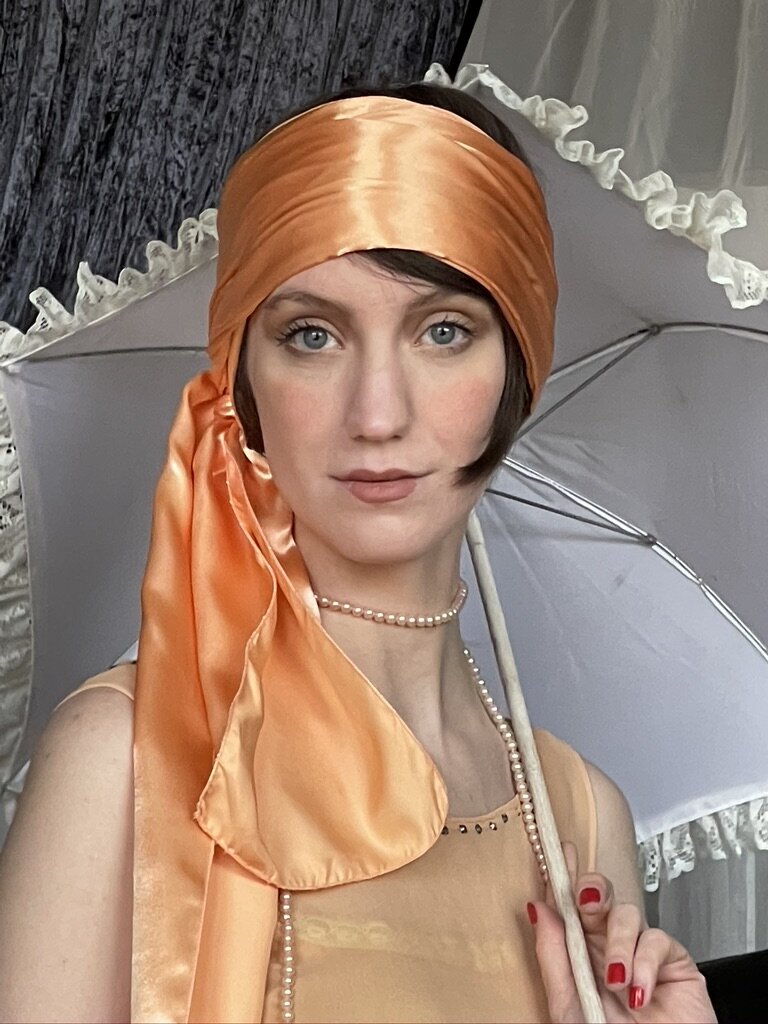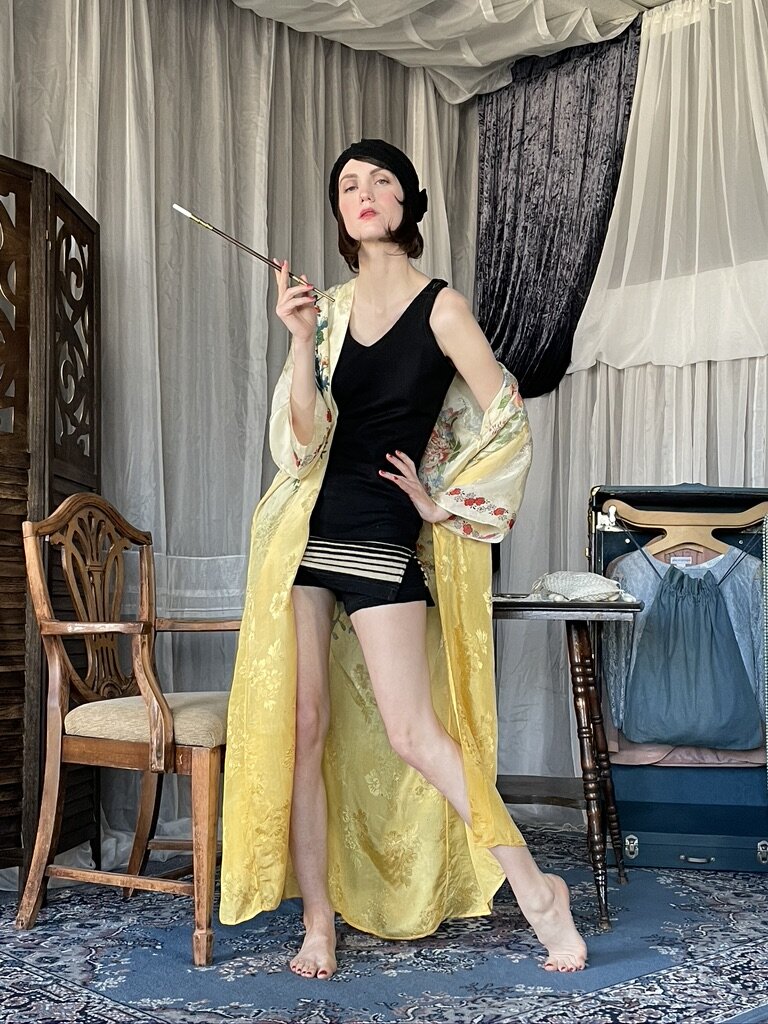WELCOME
TO THE 1920s
The Model & Producer of This Video is Actress Oakley Boycott.
The Dress, Accessories & Set are part of the Flappers to Fringe collection.
Scroll Down to View the Exhibit.
1920s: The Jazz Age, Roaring Twenties
The Bluenoses, Bearcats & Bee’s Knees
Bluenoses, bearcats and bee’s knees all came barreling in with the twenties.
The bluenoses or prudes were turning up their noses at the bearcats, otherwise known as the flappers,
and it seems everyone was looking for something or someone deserving to be referred to as, “the bee’s knees.”
The decade had a split personality – Drab and Devine.
The attitude
The “Flapper Girl”
Many young women coming of age in the 1920s were developing an attitude, you might say. They were throwing out the rules, throwing off their corsets and throwing up their heels. By this time, they’d suffered through a world war, a flu pandemic and the constrictive Edwardian styles and mores of the previous decade.
Looking at it from this perspective, it’s no wonder they were letting loose. That meant clothing styles had to keep up with the times. So, for this new generation, that was on the move and kicking up their heels, up went the hems, down went the waists and off went the hair.
And they were taking their fashion tips from more than newspapers, magazines and catalogues. They were now becoming worldly, through the magic of film, or “flickers” as they were first called, and were seeing news and FASHION REELS and emulating their favorite starlets of the day.
The Shoes
I purchased these Via Accenti shoes in 2004 when I was costuming “Inherit the Wind,” which takes place in 1925. I thought they’d be perfect because this Edwardian style was still fashionable in the 1920s, but, alas, they did not fit my actress. At the same time, I bought a pair for myself. So, that's the pair you see, here, on Oakley. The other pair is now for sale in The Shop.
This style really is so versatile because it moves easily from Victorian, to Edwardian, to Flapper, to Mod. And, they’re so cute.
The Dress
This sweet “flapper” dress, above and below, has an unusual pleated neckline and fringe that drops from just below the waist. Yes, flapper dresses did have fringe. The cloche hat and stockings are also vintage from my collection. Only the shoes are reproduction. The dress came to me through the purge of a regional theater group. I wore it a few years back to sing for Lillian LeGro’s 100th birthday party. She was a fashion designer living in Chicago in the 1930s. (Stay tuned for more on Lillian.)
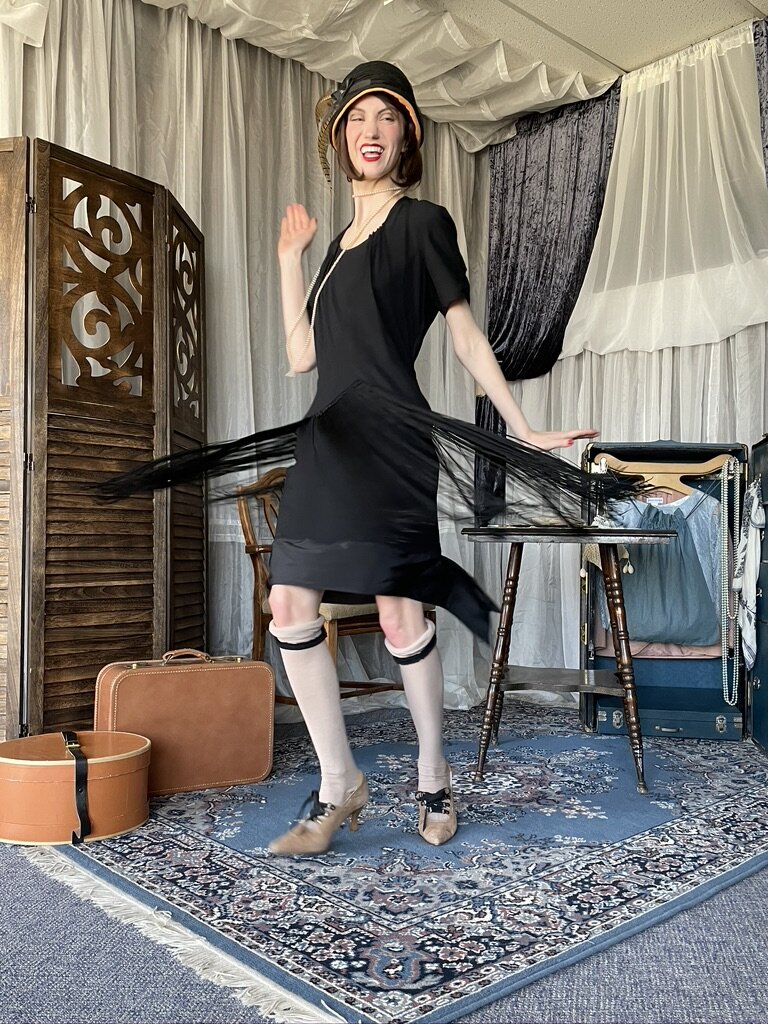
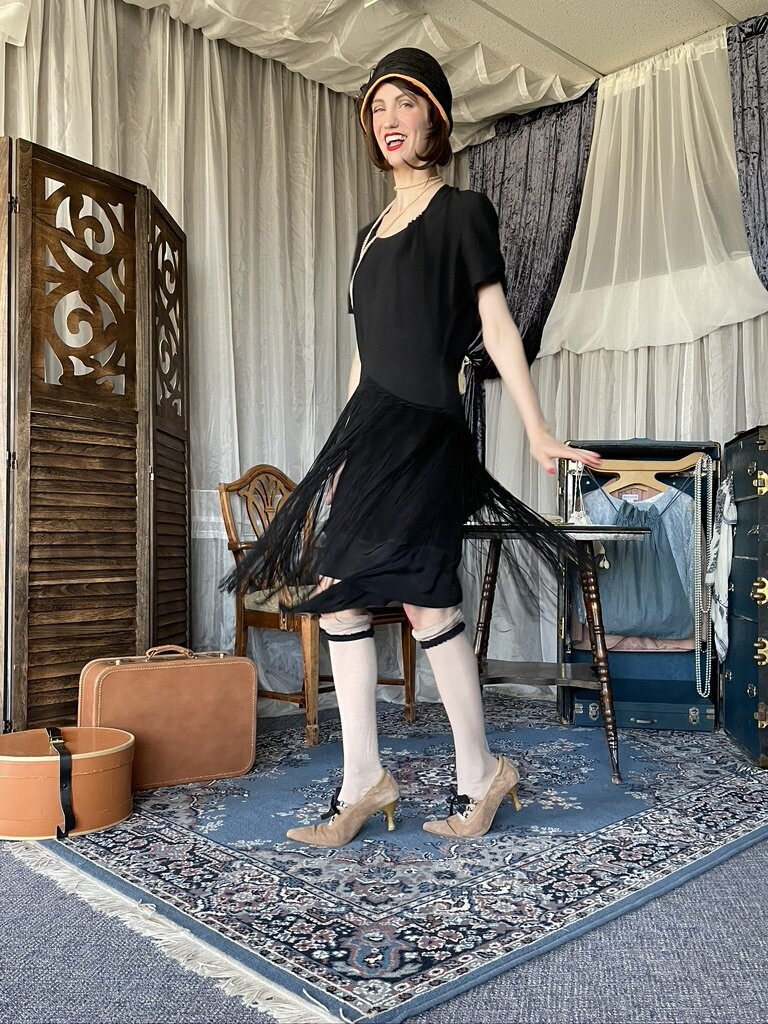

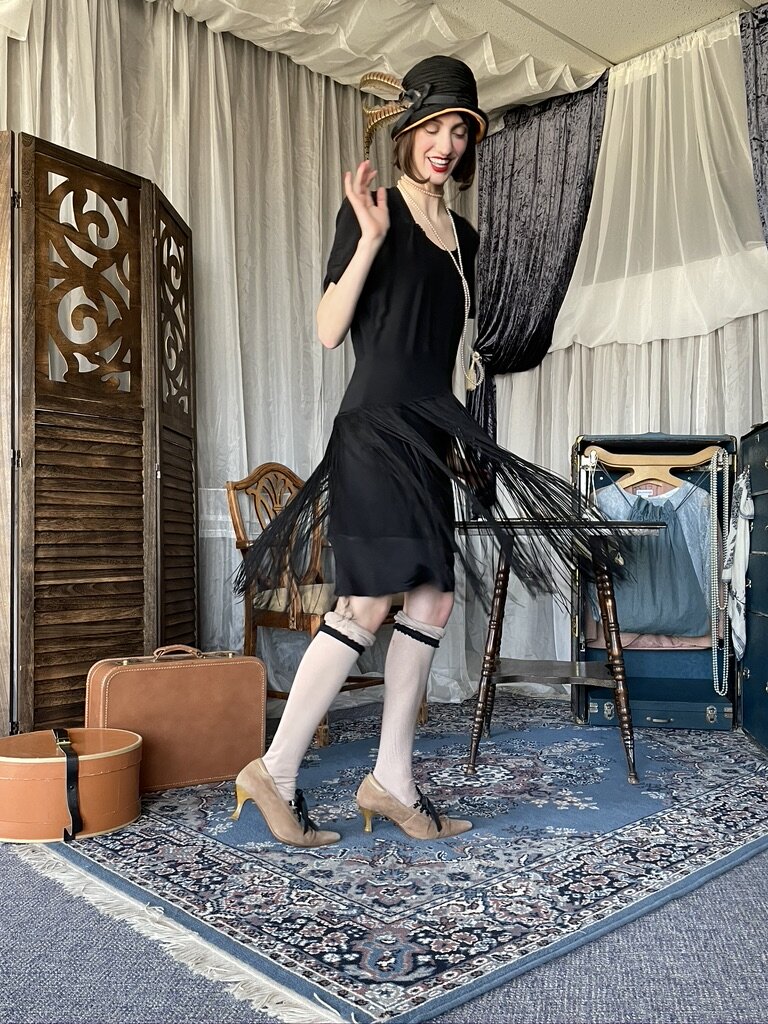
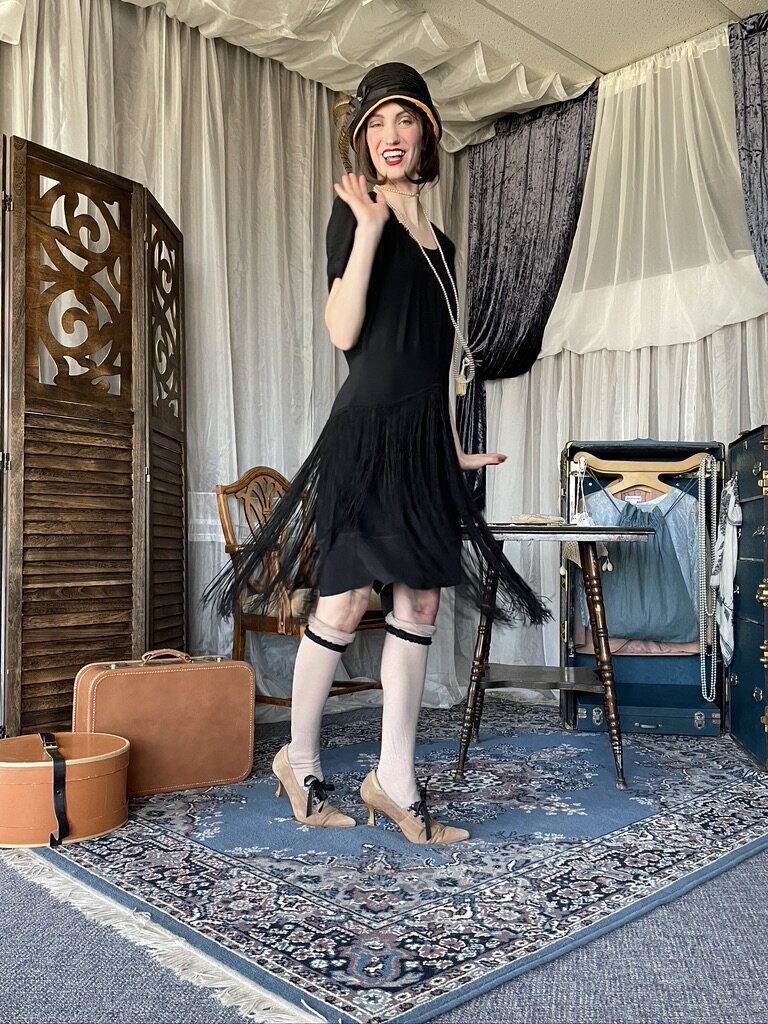
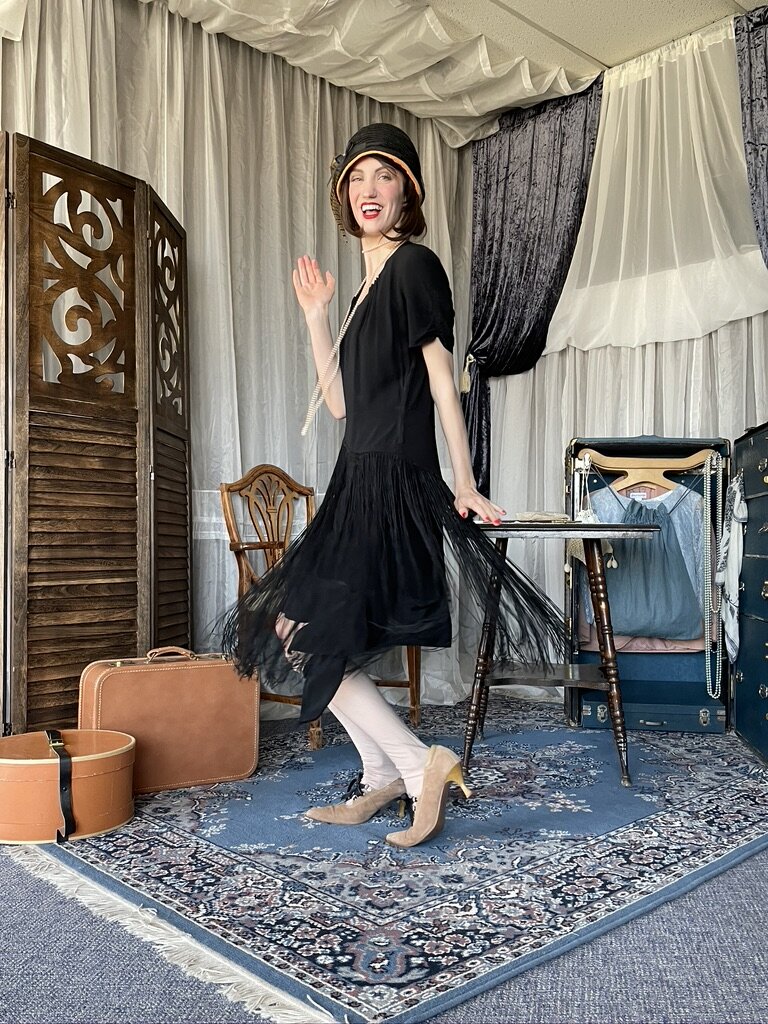
Scandalous!
Many a young woman coming of age in the 1920s definitely did embrace the “flapper girl” attitude because the concern had gone mainstream. Standing testament to that fact is this article in my March 1922 McCall’s magazine.
I was actually surprised to learn this because other historical reports I’d read suggested the “flapper girl” hadn’t come into being until the middle of the decade. This definitely disputes that notion and shows that the “flapper girl” had not only gone mainstream but was causing concern.
Yet, some of the pattern illustrations in the same magazine show loose fitting dresses that did not require corsets. (Ads shown below) A bit of a mixed message to the readers, it seems. This was a concern, you understand, because the “flapper girl” was assumed to be of loose morals and the goal of many a mother, at this time, was to have her daughter be “the marrying kind.”
So, being a wild “flapper girl” did not fit that bill. Now, if you do take time to zoom in on this article by Mrs. Winona Wilcox, who must have been the “Dear Abby” of her day, remember that “petting” in this era meant “kissing,” and that, apparently, was bad enough.
Here’s an excerpt from the March 1922 McCall’s magazine’s Dear Mrs. Wilcox feature.
Dear Mrs. Wilcox:
“I’ve lost the man I love because I’ve been permitting him to kiss me every time he called. We were not engaged and now we never will be, but he liked me tremendously from the first and I was sure he would propose to me. Now it’s over. My heart is broken and it’s all my fault! I am considered a nice girl but he thinks I let all the men kiss me and so he has left me. How can I convince him that I am worthy to be his wife? — G.F.R., Kansas City, Mo.”
Mrs. Wilcox response: “The girl can hardly convince the man that she is unsophisticated when she has already made him certain of her liking for petting parties.”
Woah! That wasn’t helpful. But that’s the way it was. For sure!
Just read this doctor’s list of qualifications he requires for any woman who wants to be his wife. It’s exhausting. — CLICK. HERE.
None of these beautiful lovelies pictured in the latest frocks from McCall’s magazine would have made the doctor’s cut.
McCall’s magazine, May, 1925. Expired Copyright
From the Stage
Influential People
LIBBY HOLMAN
One of the fashion influencers of the 1920s and ‘30s was Broadway star and torch singer Libby Holman.
Elizabeth Lloyd Holzman aka Libby Holman
In her heyday in the late 1920s to early ‘30s, Libby Holman was the talk of Broadway with two hit shows, and two hit songs, “Moanin’ Low” and “Body and Soul.” She was an extraordinary woman who rose from early poverty to great fame and fortune, earning more than $2,500 a week at one point, yet her life was troubled and tragic. You can read more about that in my blog. As for styles, she popularized the beach pajama look, wearing the outfit in public no less, and smoked cigarettes using a very stylish quellazaire, which is a cigarette holder of the long-stem variety.
Here’s an excerpt from the book, “Libby,” by Milt Machlin
“The Legend”
“In 1932, when the world was stumbling through the greatest economic depression in modern times, Libby Holman was at the height of a fantastic career. … The sultry, black-haired torch singer was the biggest star on Broadway. … Only three years earlier, Libby Holman, then 25, had received an ovation when she stopped the show with her rendition of “Moanin’ Low,” in “The Little Show,” a Broadway revue in which she co-starred with Clifton Webb and Fred Allen. Critics raved over her voice. Brooks Atkinson described it as a ‘dark purple flame.’ ”
To learn more about the legendary torch singer and hear a bit of her singing “Moanin’ Low” …CLICK HERE
The beach pajama outfit from my collection is a three-piece, so includes a kimono-style robe. cLKP
A Fashion Tidbit: As for the first to wear a pantsuit, that accolade goes to Sarah Bernhardt, according to Peter Rader. In his book, “Playing to the Gods,” he says the legendary actress was the first woman of fame to wear and be photographed in pants.
Bernhardt was an accomplished sculptor and needed a garment other than a dress that allowed for movement. So, she commissioned an haute couture pantsuit be made in white silk, complete with a foulard for her to wear when she was sculpting. An elegant solution, I must say.
JOSEPHINE BAKER
Freda Josephine McDonald
aka Josephine Baker
Another fashion influencer of the day coming from the stage was a friend of Libby Holman’s - Josephine Baker.
She had an affinity for Art Deco prints and became famous for being draped in pearls, ultimately becoming known as the Queen of Accessorizing.
This draping or double-wrapping of pearls was a look that continued through the 1970s and beyond.
Oakley, Draped in Pearls
Here’s Oakley in the double-wrap style of multi-strand strings of pearls made popular by Josephine Baker. These are actually vintage pearls from the 1920s that I picked up at a thrift shop in the 1970s because the look was back in style. Copyright LKP
From the Screen
INFLUENTIAL PEOPLE
Other fashion influencers came from the silver screen or “flickers” as they were called. Women would see the latest fashions worn by their favorite actresses, then go home and recreate them or pass the task on to their dressmaker. Famous stars of the day included Clara Bow and Louise Brooks.
CLARA BOW
Clara Bow Expired Copyright
Any young woman who wanted to become a “flapper” need only take cues from starlet Clara Bow, who became known as the ultimate “flapper girl.” She wore dropped-waist dresses with accordion pleat skirts by day, then amped them up for evening by adding sequins and fringe.
LOUISE BROOKS
Or if she leaned toward a stream-lined look, she had actress Louise Brooks as a model. Brooks bobbed her hair and wore cloche hats with Coco Chanel suit dresses and palazzo-style trousers.
Louise Brooks 1926 Expired Copyright
The verdict remains out, still, on who actually started the bobbed hair craze. Some historians say it was Brooks, others say it was actress Colleen Moore. There was also something called the Eton Crop, but I haven’t found exact pictures of that hairstyle, yet.
My Flapper Gown Copyright LKP
The Back Story: I purchased my flapper gown at a thrift store in the 1990s to wear in the musical, “Mame,” as Vera. I did wear the gown, unfortunately, which was not kind to this once very beautiful dress. It’s still holding together, but just barely, because the crepe material is disintegrating. I’m still working on ways to refurbish the piece because the silver-threaded rhinestone design is really gorgeous.
Oakley Boycott 2021 Copyright LKP
In addition to the cropped hairstyles of the day that many women were embracing, there were many others, styled to each woman’s individual taste. A good example of that is “The Etude” magazine cover from March of 1922. Just CLICK HERE to check out the link …
IRENE CASTLE
AS MENTIONED
Many a young woman of the 1920s looked to their McCall’s magazine for the latest fashions and dress patterns.
Irene Castle 1922 Expired Copyright
McCall’s “best dressed woman in the world” in 1922 was actress/dancer Irene Castle. To read more about the McCall’s fashion icon … CLICK HERE.
INFLUENTIAL PLACES & EVENTS
All things Egyptian became fashion influencers of the 1920s because of a major discovery.
To read more and see my version of The EXPEDITION LOOK … CLICK HERE.
Others from The Screen
Gloria Swanson
Now for those who sought the glamorous look, they need look no further than actress Gloria Swanson. She’s been called the “Lady Gaga” of the Jazz Age because of her affinity to bejeweled and bedazzled gowns.
Davies, Garbo, Crawford
Other fashion fads were ushered in by other famous women of the day – the head scarf bow wrap by Marion Davies and the dropped-waist evening gown by the legendary Greta Garbo, who favored designer Valentina Schlee and was dubbed “the temptress.” And there was also Joan Crawford who represented the simpler sportier look, especially in swimwear and sportswear.
Other influential stars of the day were: Lillian Gish, Norma Shearer, Myrna Loy, Tallulah Bankhead, Jeanne Eagels, Dorothy Parker and Bea Lillie.
The Silhouette, The Style, The Splash
Here’s my friend model Oakley Boycott absolutely captivating in one of the cloche hats in my collection, the definitive hat style of the decade that topped off any silhouette. Copyright LKP
The Silhouette
The dress silhouette of the 1920s ranged from long and sleek to short and bouffant, with the three most popular styles being: the chemise, which we know as the “flapper dress;” the robe de style, which featured a flouncy, gathered skirt; and the Little Black Dress. All three were favorites of this new carefree woman of the Roaring Twenties because, as you might well imagine, they did not require a corset or any rigid underfittings like dresses of the past.
The basic chemise was a column-like shift that fell in a straight line to the ankles, many times dropping into a handkerchief hem. It was “thee” style of the era, according to historian Emmanuelle Dirix, because it fully embodied the decade’s three major silhouette features – a hemline raised to the calves or scandalously to just below the knee, a dropped loose-fitting waist, and a straight, tubular shape.
And “put them together and what have you got?” as the Disney “Magic” song asks?
The “flapper dress.”
Bibbidi-Bobbidi-Boo! (I’m singing that, now.)
The robe de style, with its fitted bodice and gathered skirt was inspired by the mantua style of the 17th Century, according to Dirix. The bodice was waist-length or sometimes slightly-dropped, with the skirt held out on the sides by padding or a frame called a pannier, and falling below the knees or sometimes to the floor. I would venture to say this style is the precursor to the modern sheath dress.
CLICK HERE TO SEE and LEARN MORE about THE ROBE DE STYLE
The Little Black Dress was a little of both – stylish and elegant, yet simple of form and fabric. It went down as the innovation or “splash” of the decade, which, if you continue reading, you’ll find more details further on.
The Style
The drastic style changes of the 1920s were a direct result of the change in attitude, which went from prim and proper to free and spirited. Then completing this new look were tight-fitting cloche hats, head-wraps and beaded headbands over bobbed hairdos, jewelry that was strings of pearls, glitzy rhinestones with Art Deco-inspired designs and long-stemmed cigarette holders. All of these accessories adorned the new youth-driven society that created the “flapper dress” revolution.
This most recognized silhouette of the 1920s, the “flapper dress,” featured a boyish fit with dropped waist, vertical trim, uneven hems and decoration for evening wear that had movement and sound, like, fringe that swished and swayed, you might say, and beads that jingled and jangled. Even traditional shoes became freer in style with newly emerging low-heeled Mary Janes and T-straps, both of which were designed for dancing.
There were a few other styles, too, in addition to the main three, like the sack dress, which really was aptly named. It was pretty much a straight-sided bag slipped over the head. Surprisingly, that design idea reappeared briefly in the 1950s. However, this more modern rendition sported a triangular shape that was wide at the shoulders and narrow at the calves.
The Splash
Clearly, though, as previously mentioned, the innovation of the decade was that Little Black Dress. This new revolutionary look came from the French designer Gabrielle Chanel, who we know as “Coco.” She’s the one who came up with the idea of creating a dress that was comfortable enough to be worn all day long and could be dressed up or down, depending on the occasion.
Now, that may sound like a no-brainer. But, back then, it was a really big deal. For up to this point, women were making three to six costume changes a day, depending on their activities. One for breakfast, another for lunch, and still another for afternoon tea. That makes three, and we’re not even into the evening, yet. For that, you’d need a dinner dress, and most likely an after-dinner dress or gown for going out on the town, or to a speak-easy for drinking and dancing. On top of that, if you went shopping or played tennis any time during the day, well, you’d need a couple more outfits. Easily, then, if I’m counting correctly, your daily dress count and changes required in previous decades could easily go from three to six or more in a matter of hours. So, you can see, how this little idea of one dress for the whole day was truly revolutionary and certainly not acceptable to some of “the old school,” you might say.
Still, Coco’s Little Black Dress, as it was dubbed then and now, when it was introduced in 1926 in Vogue magazine seemed to embody the new found principals of the fashionable young woman of the day – freedom of rules, regulations, morals, etiquette and above all, movement. This was the clear innovation of the decade, according to historians. This one fashionable Little Black Dress of crepe fabric was so simple and elegant it could be worn from morning ‘til night and for all activities, from eating, to exercising, to dancing the night away. Consequently, this style and fabric choice, in black, no less, the color reserved for mourning, emerged as the dress which offered the perfect balance of comfort and style.
Chanel really was the most influential of all couturiers of the decade, according to historian Tom Tierney. Already a successful designer during the World War I period, she became an international celebrity, who was even designing costumes for movies in the United States. Her guiding principle, he said, was simplicity and she was best known for her perfectly balanced, elegantly understated ensembles. She was the first, he said, to use jersey as an haute-couture fabric and it was her influence, he says, that marked the rise in hemlines in the middle of the decade.
The Progression
In the Beginning
Though the style change of the 1920s may seem drastic compared to the uber-fitted Edwardian styles and hobble-skirts of the previous decade, it came about through a slow progression of bodices becoming less structured and skirt lengths moving upward. As hems rose, then, waistlines dropped and this looser fitting dress morphed into the chemise.
The Middle
The progression, then, into the “flapper look,” which was introduced at the beginning of the decade with the movie, “The Flapper,” came fully unto the fashion scene in the mid-20s.
CLICK HERE FOR MORE ON THE FLAPPER
This look of a suppressed bustline over narrow hips with no waistline created a boyish, androgynous silhouette free of curves. Thus, the flapper girls really were the first wave of cool androgyny, according to historians. Now that the curves were eliminated and the line simpler, the overall look followed suit by being topped off by a shorter hairdo, known as the bob. Coco Channel’s Little Black Dress followed suit, somewhat, to the chemise, but brought the hemline further up to the knees. It’s surprising then, to some, that Jeanne Lanvin’s more romantic robe de style with its prim bodice and gathered skirt made it into the fashion picture at all. Some historians believe it was created as a more suitable alternative for the respectable young woman to wear rather than the more scandalous “flapper” style.
By the End
The great thing about all the styles introduced in the 1920s was that the patterns were simple enough to be duplicated by both the ready-to-wear market and the home sewer. Any of the dress styles, simple or elaborate, could be had by most because fashions were now being mass produced.
But it was the simplicity of the three major silhouettes that were really the gifts that changed the game. That’s because all three styles, especially the shift dress, were simple enough to be made by the home sewer, which meant the middle-class woman could be just as fashionable as the upper-class. Patterns, too, were readily available through magazines like McCall’s, and going this route added the bonus of tailoring a design to fit your own personal style and shape. That meant you could choose a long hemline or short one, with sleeves or no sleeves at all, or go with a cami-style bodice held up by spaghetti straps, a look perceived by some as ultra-revealing and very sexy. Did you hear that? They brought sexy back, like Justin Timberlake, and they didn’t even know it. Only, theirs was brought back from a centuries-old cover up of the woman’s body. How scandalous?! Even more racy was the newly introduced sportswear with fitted sweaters and short knee-length skirts. Oh, my!
So, who would have thought that by the end of the decade, these short, shift-like tennis dresses would not only become fashionable but acceptable among all the social classes, even with the royals. I found proof, in an old publication I picked up at an antique store years ago. Printed in the magazine are pictures of Princess Alexis Karageorgevitch, along with Mrs. Franklin Mott Gunther, playing a round of golf at the Engadine Golf Club at Samaden, Switzerland, and Princess Fabrizio Pignatelli playing at the Kulm course at St. Moritz, in Switzerland. The publication is The Spur magazine, August 1929 issue, which seems to be a magazine that catered to the ultra-wealthy equestrian, country, traveling set.
You can see the pictures by CLICKING HERE.
The Sailor Flap
The Back Flap Square Sailor’s Collar in women’s fashion was inspired by Navy uniforms. The original back flaps were button-on and designed to protect shirts from hair tar, according to the Naval History & Heritage Command website. Now, I’m not exactly sure what that hair goop was made of but it must have made one greasy, grimy mess because it ultimately inspired the creation of a designer shirt. And, that’s pretty cool.
I paired my little tennis shift with a vintage sailor top and hat. (The hat was a gift from a friend, circa 1970s.) Had to fudge on the shoes and use a pair of old cloggers with the taps taken off. Copyright LKP
Now, you’d think that it’d be all this emergence of “sexy” that carried us into the 1930s glam era. Not so. Remember? There was that little bump in the road called The Great Depression. So, just as we were beginning to find our freedom and kick up our heels, the rug was pulled out from under us and the fashion scene not only took a dive but came crashing down around us. This new modern Jazz Age that came roaring in like a lion to become the decade of “puttin’ on the ritz,” truly did end with a crash.
As a result, the decade came to a close with women falling back on what was possibly more secure and familiar, a more figure-forming feminine look for which they were even growing out their hair. Or maybe, like in other periods of history, letting their hair grow was a direct result of the economic downturn. Maybe, they just didn’t want to spend their extra money on what was perceived as a non-necessity, or they had no spare money to spend at all. We really don’t know.
The Wrap
As for the overall look of the waistlines and hemlines of the decade, they moved up and down throughout. Waistlines dropped until about 1923 before beginning to rise again in 1928, while the hemlines rose until 1926, then started to fall back down, again. The only exception seems to be the evening dress, which stayed at floor-length throughout the decade. Many did, however, follow the popular trend which was the handkerchief hem. It was that one particular detail that emerged as a favorite and carried on into the next decade.
HEALTH & BEAUTY TIPS
for the Woman of the 1920s
References Include: Playing to the Gods by Peter Rader; Shoe Innovations by Caroline Cox; Costume Design in the Movies by Elizabeth Leese, Dover Publications, Inc. New York, 1991; Libby by Milt Machlin; Vintage Hats & Bonnets by Susan Langley, 1998, by Collector Books; vintage McCall’s magazines; The Etude; “Memories” 1990 Aug/Sept issue; Dressing the Decades by Emmanuelle Dirix, 2016, Quid Publishing; Great Fashion Designsof the Twenties, Paper Dolls in Full Color, by Tom Tierney, Dover Publications, Inc. New York, 1983; ; “From Flappers to Flivvers” by Reminisce magazine published by Reiman Publications, L.P, 1995; ; The Spur magazine, August Issue of 1929, Naval History & Heritage Command website and several internet sites, including bartleby.com, marieclaire.com, Fashionhistory.fitnyc.edu, 1920sfashionandmusic.com, imbd.com, askinglot.com, biography.com, LoveToKnow.com, vintagefashionguild.org; fashionhistory.fitnyc.edu.




